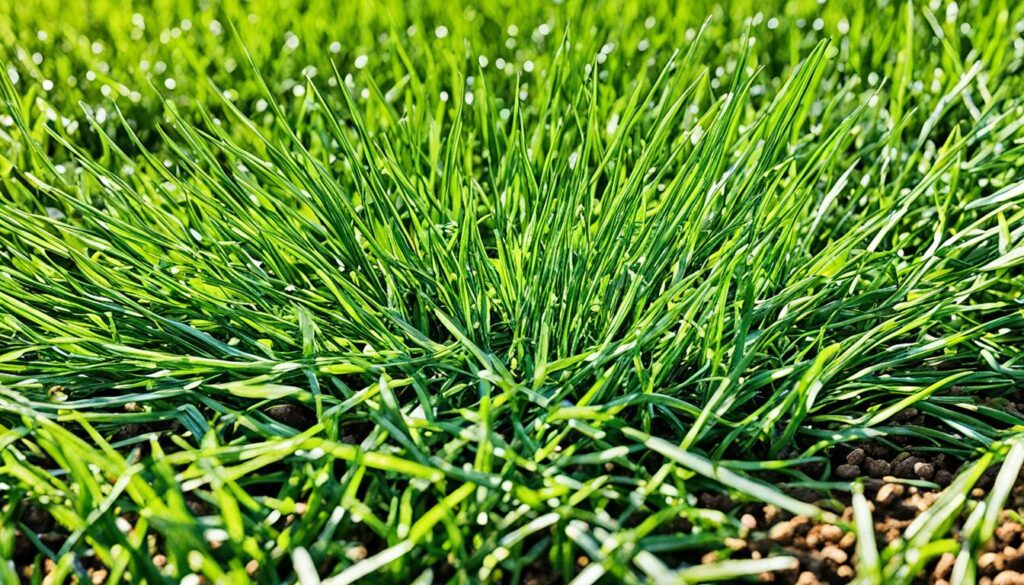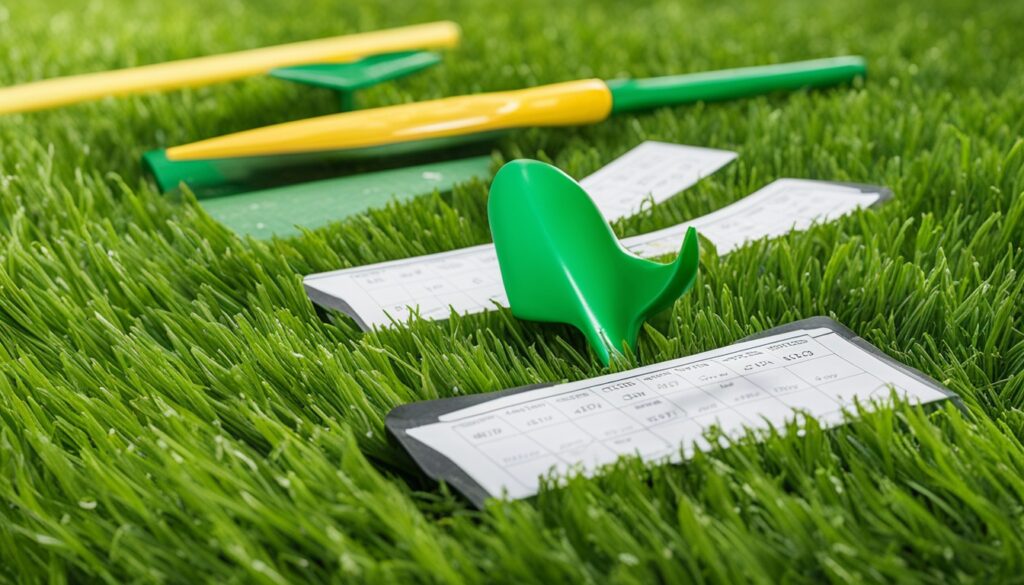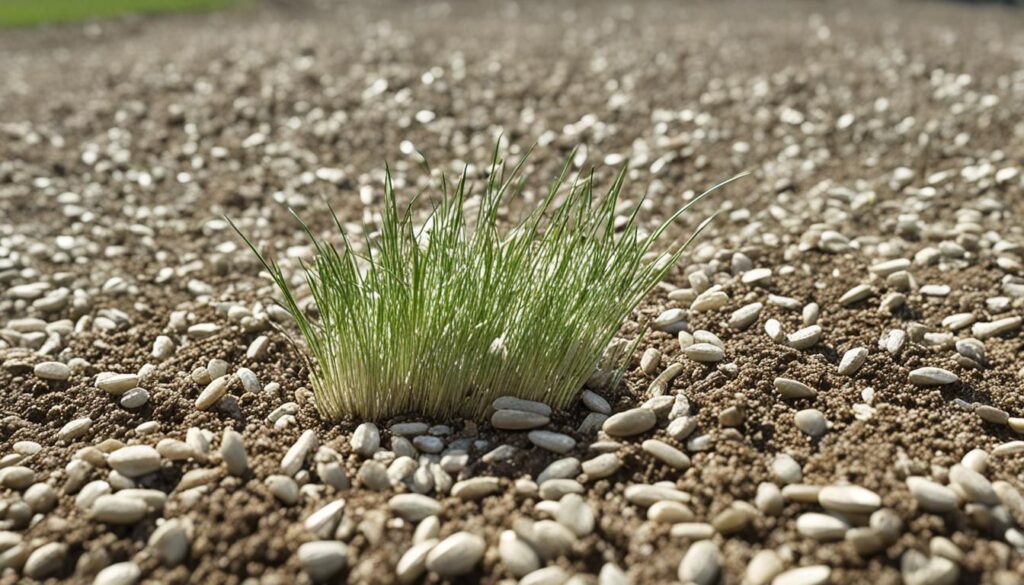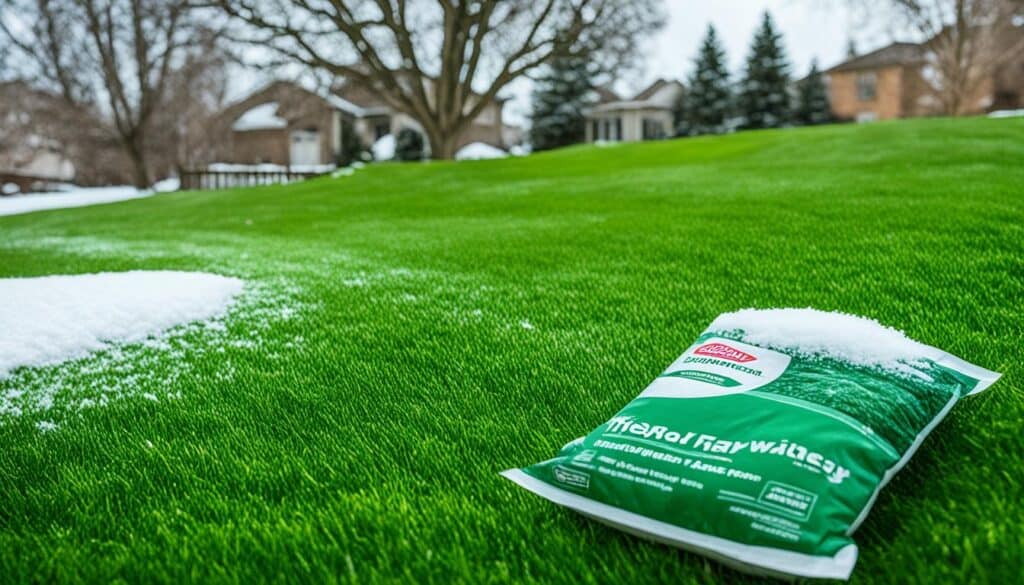Did you know 79% of Florida homeowners pick St. Augustine grass for their lawns? This fact shows how popular this warm-season turfgrass is in the Sunshine State. Knowing the best time to fertilize St. Augustine grass is key for a lush, healthy lawn all year.
St. Augustine grass loves Florida’s warm, humid weather, making it a favorite among homeowners. It can handle partial shade and is tolerant of salt too. To keep your St. Augustine lawn looking great, fertilizing at the right time is crucial.
The best times to fertilize St. Augustine grass in Florida depend on where you live. In South Florida, the best times are early spring (January-March) and late spring/early summer (April-June). For central and north Florida, the timing is a bit different because of cooler weather.
To fertilize St. Augustine grass in Florida, you need to know its specific needs. A balanced fertilizer with an N-P-K ratio of 16-4-8 or 15-0-15 in spring can help it grow well. Always test your soil to find out what nutrients your lawn needs.
Key Takeaways
- St. Augustine grass is the most popular lawn grass in Florida
- Fertilization timing varies by region in Florida
- Early spring and late spring/early summer are optimal fertilization periods
- Balanced fertilizers with specific N-P-K ratios work best for St. Augustine grass
- Soil testing helps determine precise nutrient needs
- Proper fertilization promotes lush, healthy St. Augustine lawns
Understanding St. Augustine Grass in Florida
St. Augustine grass is a favorite for lawns in Florida. It loves the Sunshine State’s warm climate. This makes it a top pick for many homeowners. Let’s dive into what makes this grass great for Florida’s landscapes.
Characteristics of St. Augustine Grass
St. Augustine grass has a coarse texture and spreads through stolons, making a dense lawn. It’s famous for its:
- Broad, flat blades
- Blue-green to dark green color
- Ability to form a thick, carpet-like turf
- Tolerance to salt and shade
Adaptation to Florida’s Climate
St. Augustine grass is a star in Florida’s climate. It excels in warm temps and high humidity, ideal for Florida’s subtropical vibe. This grass:
- Grows well in most Florida soils
- Tolerates heat and drought
- Needs less water than some other grasses
- Went dormant in cooler north Florida winters
This lets St. Augustine grass stay lush all year in most of Florida.
Common Varieties in Florida
Florida has many st. augustine grass types, each with its own perks:
- Floratam: Drought-tolerant
- Palmetto: Semi-dwarf, great for shade
- Raleigh: Cold-hardy, good for north Florida
- CitraBlue: Blue-green color, better at resisting drought
- ProVista: Tolerates shade well, resistant to glyphosate
Pick the variety that fits your lawn’s needs and your upkeep style.
Importance of Proper Fertilization for St. Augustine Grass
Proper fertilization is key to a healthy St. Augustine lawn. Knowing the benefits and risks helps you make smart lawn care choices.
Benefits of Fertilizing
Fertilizing your St. Augustine grass has many advantages. It makes your lawn thicker, greener, and more able to handle stress. It also helps roots grow strong, which is good for fighting drought and pests. Aim to use 2-6 pounds of nitrogen per 1,000 square feet each year for best results.
- Improved color and density
- Enhanced drought resistance
- Better recovery from foot traffic
- Increased ability to outcompete weeds

Consequences of Improper Fertilization
Not fertilizing right can harm your St. Augustine lawn. Too much fertilizer can cause too much thatch, make it more prone to diseases, and harm the environment. It’s important to follow the right lawn care tips to avoid these problems.
| Proper Fertilization | Improper Fertilization |
|---|---|
| Healthy, green lawn | Yellowing or browning grass |
| Balanced growth | Excessive thatch buildup |
| Improved stress tolerance | Increased disease susceptibility |
| Environmental benefits | Potential nutrient runoff |
Fertilize your St. Augustine grass every 6-8 weeks when it’s growing. Use soil test results to guide your fertilizing, keeping the pH between 5 and 8.5. By doing this, you’ll keep your lawn lush and healthy all year.
Seasonal Considerations for Fertilizing St. Augustine Grass
Knowing when to fertilize St. Augustine grass in Florida is key to a healthy lawn. The best time to fertilize changes with the seasons. It matches the grass’s growth and the weather.
Spring Fertilization
Wait for the last frost before feeding your lawn in spring. This is usually 3 weeks after it starts to green up. Then, spread 1 pound of soluble nitrogen per 1,000 square feet every 8 weeks. Or, use 1.5 pounds of slow-release nitrogen every 10 weeks.

Summer Fertilization
Keep up with fertilizing in summer to keep your lawn growing and looking great. From June to September, add 1 to 1.5 pounds of nitrogen per 1,000 square feet every 8 to 10 weeks. Choose fertilizers with little phosphorus to avoid soil buildup.
Fall Fertilization
Fall is a key time for fertilizing St. Augustine grass. October is especially important for getting your lawn ready for winter. Use a “winterizer” fertilizer with a 0-0-10 mix in November to help your lawn survive the cold.
Winter Fertilization
Don’t fertilize your lawn in winter unless you live in a specific area of Florida. November is usually the last month you should fertilize, says the University of Florida. Just water your lawn now and then to keep it from drying out.
| Season | Fertilization Timing | Nitrogen Application |
|---|---|---|
| Spring | 3 weeks after greening | 1 lb soluble N / 1000 sq ft every 8 weeks |
| Summer | June to September | 1-1.5 lbs N / 1000 sq ft every 8-10 weeks |
| Fall | October to November | Use “winterizer” fertilizer (0-0-10) |
| Winter | Not recommended | Focus on watering to prevent drought damage |
Best Time to Fertilize St. Augustine Grass in Florida
Fertilizing St. Augustine grass at the right time is key to a lush, healthy lawn in Florida. The best fertilizer varies by season and location within the state. Aim for 3-4 applications a year, as advised by the University of Florida.
In south Florida, you might fertilize all year because the grass grows longer. For central and north Florida, fertilize from April to October. Don’t fertilize during drought or when the grass is dormant. Water your lawn 2-3 times a week in spring and 2-4 times in summer for growth.
When picking the best fertilizer for St. Augustine grass, look for a balanced mix. Use a St. Augustine-safe weed and feed about two to three weeks before spring. In winter, use a low-nitrogen fertilizer if your area stays warm.
Local laws might limit when you can fertilize, especially near the coast. Always follow your local rules and consider getting a fertilizer certification if needed. By doing so, you’ll keep your St. Augustine lawn in Florida looking great.
FAQ
What are the characteristics of St. Augustine grass?
St. Augustinegrass is a warm-season grass with a coarse texture. It spreads by stolons and forms a dense, green to blue-green turf. It’s also relatively good at tolerating salt. Some common types include ‘Floratam’, ‘Bitterblue’, ‘Palmetto’, ‘Raleigh’, ‘ProVista’, and ‘CitraBlue’.
Why is proper fertilization important for St. Augustine grass?
Proper fertilization helps St. Augustine grass grow well, look better, and handle stress better. But, too much fertilizer can cause problems like thatch, more pests and diseases, and harm the environment.
When is the best time to fertilize St. Augustine grass in the spring?
Wait until the grass is fully green before fertilizing in spring to avoid damage from frost.
How often should I fertilize St. Augustine grass during the summer?
In summer, fertilize St. Augustine grass to keep it growing and looking good.
Why is fall fertilization crucial for St. Augustine grass?
Fertilizing in October is key for St. Augustine grass to stay hardy through winter.
Should I fertilize St. Augustine grass during the winter?
No, don’t fertilize St. Augustine grass in winter in most of Florida.
When is the best time to fertilize St. Augustine grass in Florida?
Fertilize St. Augustine grass in Florida from late spring to early fall. Avoid fertilizing during drought or when the grass is dormant.



